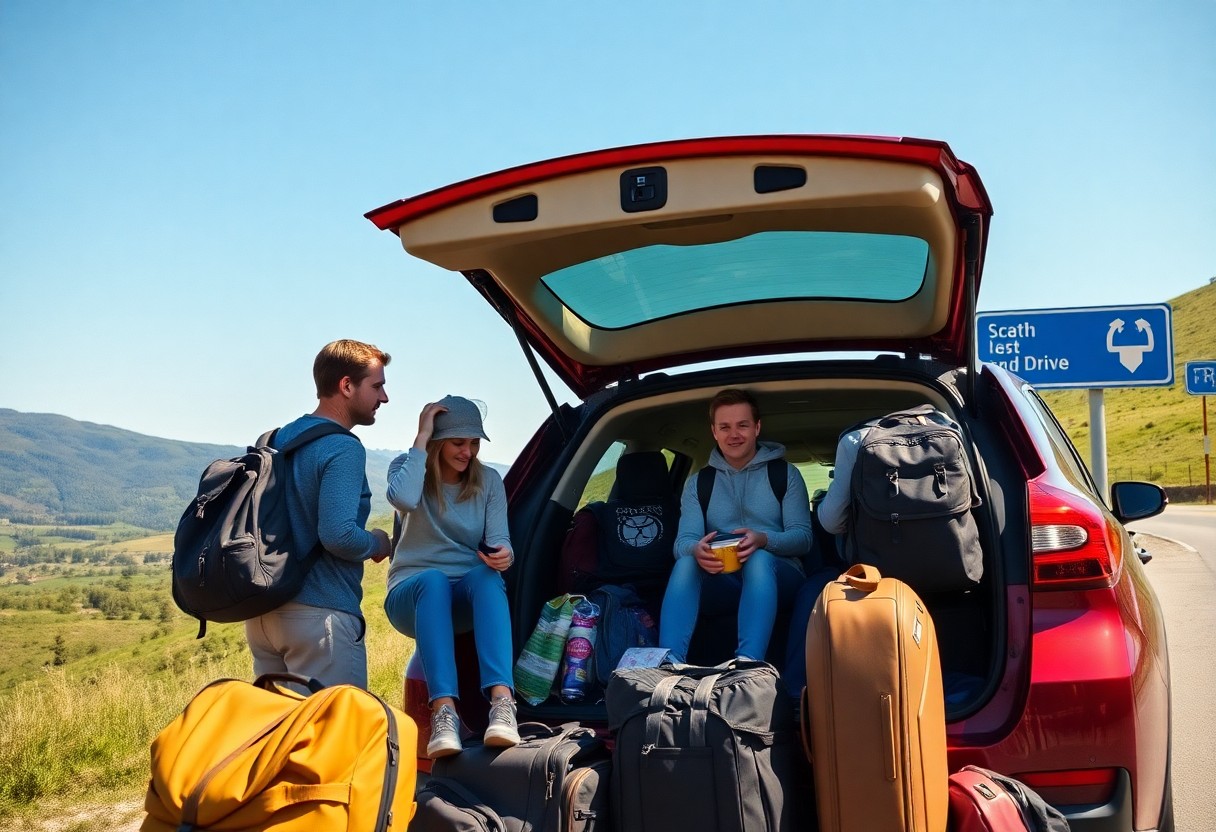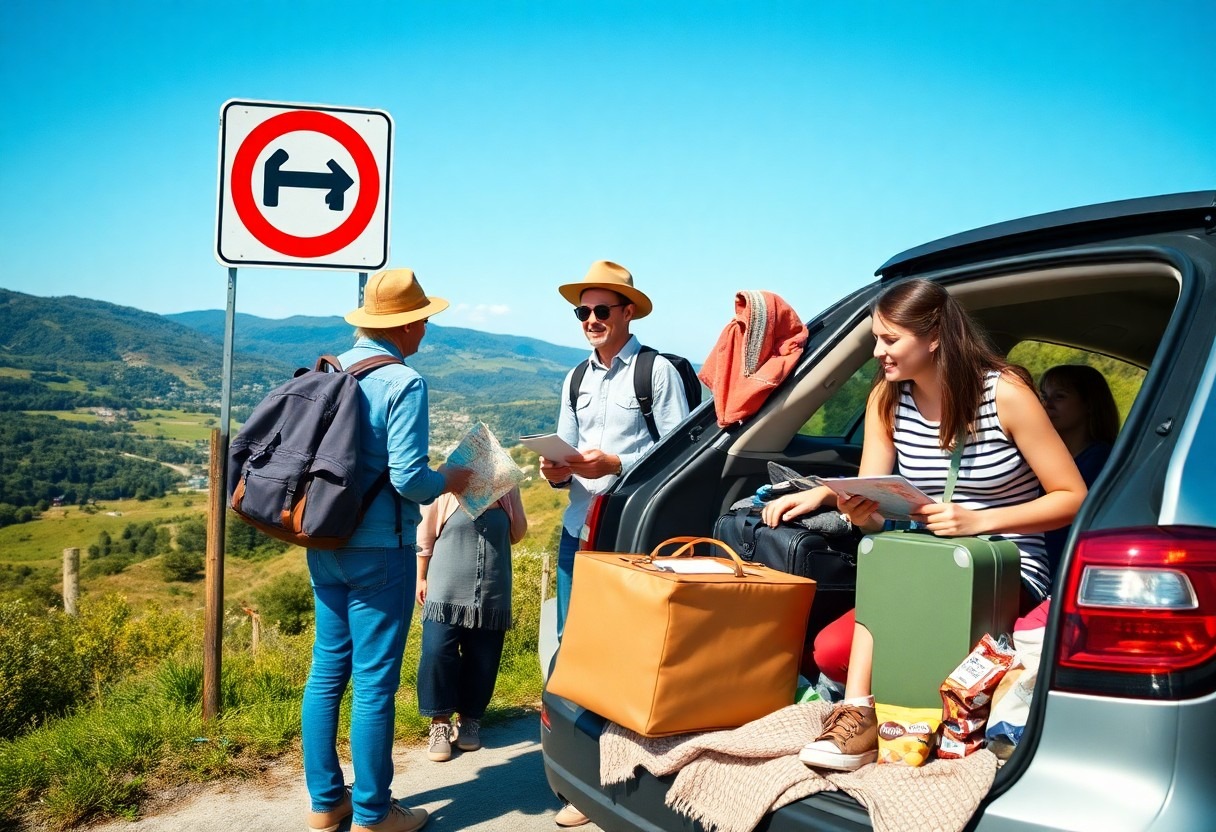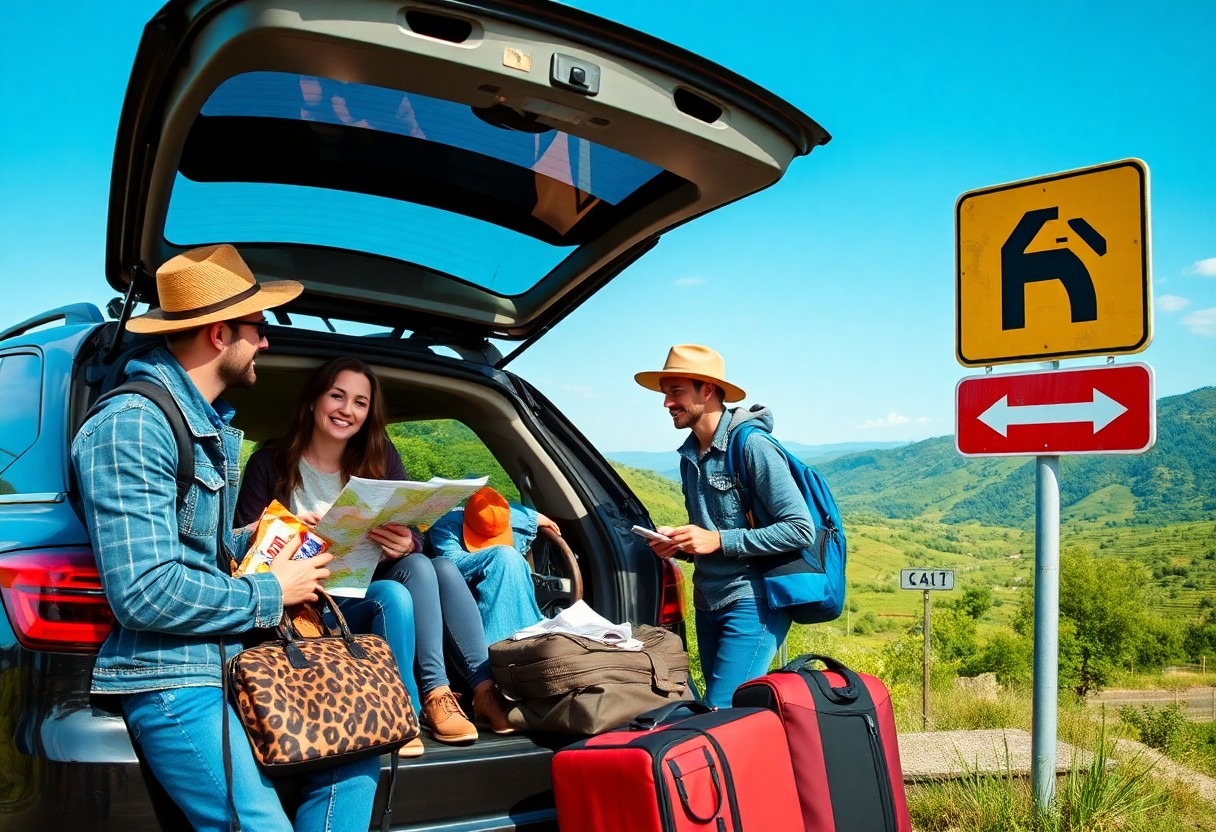When you plan to rent a car and drive in countries with left-hand traffic, you may feel nervous about the different rules of the road. You will sit on the right side of the car and drive on the left side of the road, which can be confusing at first. To ensure a safe and fun road trip, you need to understand the local traffic laws and regulations. You will learn how to adjust to driving on the left and avoid common mistakes that can lead to accidents or fines. With the right preparation and knowledge, you can enjoy a stress-free and enjoyable road trip in left-hand drive countries, and make the most of your car rental experience.

Types of Traffic Systems
Before you rent a car and start driving in a foreign country, it’s necessary to understand the local traffic rules. You should know the following:
- Left-hand traffic countries
- Right-hand traffic countries
The following table provides more information:
| Country | Traffic System |
|---|---|
| UK | Left-hand traffic |
| USA | Right-hand traffic |
| Australia | Left-hand traffic |
| Germany | Right-hand traffic |
| Japan | Left-hand traffic |
Left-Hand Traffic Countries
If you’re planning to visit countries like the UK, Australia, or Japan, you should be aware that they have left-hand traffic systems, where you drive on the left side of the road.
Right-Hand Traffic Countries
While many countries have right-hand traffic systems, such as the USA and Germany, you should still exercise caution when driving in these countries, especially if you’re used to driving on the left side.
It is important to note that car rental companies usually provide vehicles with the steering wheel on the correct side for the local traffic system, so you don’t have to worry about driving on the wrong side. However, you should still be aware of the local traffic rules and regulations to ensure a safe and enjoyable trip. You can rent a car with confidence, knowing that you have the necessary knowledge to navigate the local roads.

Factors to Consider When Driving Abroad
If you’re planning to rent a car and drive in a left-hand drive country, consider the following factors:
- Road rules and regulations
- Vehicle design and specifications
Any car rental company will provide you with a vehicle suitable for driving in a left-hand drive country.
Road Rules and Regulations
Often, driving in a foreign country can be challenging due to different road rules and regulations. Most countries have similar rules, but some may have specific traffic laws that you should be aware of. For instance, in some countries, pedestrians have the right of way, while in others, cars do.
Vehicle Design and Specifications
Specifications of vehicles vary depending on the traffic system in place. In left-hand drive countries, the driver’s seat is on the right side of the vehicle, which can be confusing for drivers from right-hand drive countries.
This difference in vehicle design can be dangerous if you’re not used to it. For example, when renting a car in a left-hand drive country, you should ensure that you’re comfortable with the vehicle’s specifications and road rules to avoid any accidents. You should also be aware of the traffic laws and penalties for violating them. By understanding these factors, you can have a safe and fun road trip in a left-hand drive country.
Step-by-Step Guide to Driving in Left-Hand Traffic Countries
Some countries have left-hand traffic, requiring you to adjust your driving habits. The following table highlights key points to consider:
| Country | Traffic Side |
|---|---|
| UK, Australia, New Zealand | Left |
| USA, Canada, Europe (most countries) | Right |
Pre-Trip Preparations
If you’re planning to rent a car in a left-hand traffic country, ensure you’re familiar with the local traffic rules and regulations. You should also check if your car rental company provides vehicles with the steering wheel on the right side.
Adjusting to Left-Hand Driving
Adjusting to left-hand driving can be challenging, but with practice, you’ll become comfortable. You’ll need to get used to driving on the left side of the road, and the driver’s seat will be on the right side of the vehicle.
LeftHand traffic rules can be confusing, especially when it comes to roundabouts and intersections. You should always yield to the right and be aware of pedestrians and cyclists. It’s important to follow local traffic rules and drive defensively to ensure a safe and enjoyable trip. Remember to rent a car that suits your needs, and don’t hesitate to ask your car rental company for guidance on driving in left-hand traffic countries.

Pros and Cons of Driving in Left-Hand Traffic Countries
Unlike other driving experiences, driving in left-hand traffic countries has its advantages and disadvantages. Here are some key points to consider:
| Pros | Cons |
|---|---|
| Unique experience | Confusion on the road |
| Scenic routes | Right-hand drive car rental limitations |
| Cultural immersion | Higher accident risk |
| Varied landscapes | Driving fatigue |
Advantages of Left-Hand Driving
LeftHand driving can be a thrilling experience, offering you a chance to explore new countries and cultures. You’ll have the opportunity to drive on scenic routes and enjoy varied landscapes, making your trip even more memorable.
Disadvantages of Left-Hand Driving
For many drivers, left-hand traffic can be confusing, especially when it comes to roundabouts and intersections. You may need to adjust to different road signs and markings, and be aware of pedestrian traffic and bicycle lanes.
LeftHand driving can also be challenging when renting a car, as right-hand drive vehicles may not be readily available. Additionally, you may experience driving fatigue due to the unfamiliar traffic patterns, which can increase your risk of being involved in an accident. To minimize these risks, consider renting a car from a reputable company that offers left-hand drive vehicles, and take regular breaks during long drives to stay alert and safe on the road.
Tips for a Safe and Fun Road Trip
To ensure a safe and enjoyable journey in left-hand drive countries, consider the following:
- Choose a car rental that suits your needs
- Familiarize yourself with local road signs and signals
- Manage fatigue and stress while driving
Assume that these tips will help you navigate through unfamiliar roads with confidence.
Understanding Local Road Signs and Signals
While driving in left-hand drive countries, it’s imperative to understand local road signs and signals to avoid confusion and ensure your safety.
Managing Fatigue and Stress While Driving
For a safe and enjoyable road trip, it’s critical to manage fatigue and stress while driving, especially in unfamiliar territories.
Another important aspect of managing fatigue and stress is to take regular breaks, stay hydrated, and avoid driving when tired. You can rent a car that has features such as driver assistance systems to help reduce fatigue and stress. By following these tips, you can have a safe and enjoyable road trip in left-hand drive countries.
Countries with Left-Hand Traffic
Keep in mind that left-hand traffic countries require you to drive on the left side of the road, which can be challenging for those accustomed to right-hand traffic. Safety is a top priority, so it’s imperative to be aware of the local traffic rules and regulations.
European Countries
While exploring European countries, you’ll find that only a few, such as the UK, Ireland, Malta, and Cyprus, drive on the left. These countries have limited road connections to right-hand traffic countries, making it easier to navigate.
Asian and African Countries
Now, when traveling to Asia and Africa, you’ll encounter more countries with left-hand traffic, including India, Japan, and South Africa. Be aware of the local traffic rules and exercise caution when driving in these countries.
Traffic rules in these countries can be quite different from what you’re used to, so it’s imperative to research and understand the local regulations before renting a car. For instance, in Japan, you’ll need to adjust to narrow roads and unique traffic signs.
Americas and the Pacific
Now, when traveling to the Americas and the Pacific, you’ll find that countries like Australia, New Zealand, and some island nations drive on the left. Rent a car from a reputable company and review the traffic rules before begining on your journey.
European countries like the UK have a significant influence on the traffic rules in these regions, so you’ll find similarities in traffic laws. However, it’s still imperative to familiarize yourself with the local regulations and drive defensively to ensure a safe and enjoyable trip. If you plan to rent a car, make sure to choose a reputable car rental company that provides vehicles with proper safety features.
Final Words
Summing up, you now have vital tips for a safe and fun road trip in left-hand drive countries. You know which countries drive on the left and what to consider when renting a car. With this knowledge, you can enjoy your trip and drive safely. Remember to check the traffic rules and rent a car that suits your needs. Have a great trip!
FAQ
What countries have left-hand traffic and what are the key considerations for driving in these countries?
Countries that drive on the left include the UK, Ireland, Malta, Cyprus, and several countries in Asia, Africa, and the Caribbean that were formerly part of the British Commonwealth. When driving in these countries, it’s vital to be aware that vehicles are designed with the driver sitting on the right side of the car, and road rules and signs may differ from those in right-hand traffic countries. If you plan to rent a car, ensure you understand the local traffic laws and road signs to have a safe and enjoyable trip.
How do I prepare for driving in a left-hand traffic country, especially if I’m used to driving on the right?
To prepare for driving in a left-hand traffic country, start by familiarizing yourself with the local road rules and signs. Practice driving on the left side of the road in a safe and controlled environment, such as an empty parking lot, to get used to the feeling of driving on the opposite side. Consider renting a car with an automatic transmission to reduce the complexity of driving in a new environment. Additionally, take your time and be patient, as it may take some time to adjust to the new driving conditions.
What are some vital tips for a safe and fun road trip in left-hand drive countries, and how can I rent a car for my trip?
For a safe and fun road trip in left-hand drive countries, plan your route in advance, check the weather forecast, and ensure your vehicle is in good condition. When renting a car, choose a reputable car rental company and carefully review the terms and conditions of your rental agreement. Consider booking a car with a GPS system or renting a car with a driver if you’re not comfortable driving in a new environment. Always wear your seatbelt, follow local traffic laws, and be mindful of pedestrians and cyclists to ensure a safe and enjoyable trip. Renting a car can be a great way to explore new destinations, so be sure to research and compare prices to find the best option for your needs.




Your insights about driving in left-hand traffic countries resonate with me; the first time I drove in the UK, I remember feeling overwhelmed yet excited. It’s fascinating how something as simple as side of the road can impact our mindset and driving habits. I think it’s also important to consider how cultural attitudes toward driving can differ. For instance, in some countries, honking is seen as rude, while in others, it’s just part of the driving experience.
You’ve hit on something really interesting—the way driving is not just about getting from point A to point B, but also how it reflects broader cultural norms and attitudes. I remember my own first experience behind the wheel in the UK. Everything felt backward at first, from the street signs to how I held the steering wheel. I had to school my brain not just in terms of where to drive, but in how to interact with other drivers. It’s like a dance that you’ve never learned the steps to.
You’ve captured that feeling perfectly—the initial chaos of navigating a new driving environment really hits home. I remember having a similar experience when I took a road trip in Australia. The shift to driving on the left was jarring, and those roundabouts took some serious getting used to. It’s fascinating how much our driving style can embody cultural nuances, from how aggressively people merge to the unwritten rules of politeness on the road.
You’ve described that feeling behind the wheel so well. I remember my own first time driving in a different country, and it really highlighted how ingrained our cultural norms are, even in something as routine as driving. I drove in Japan, where not only did I have to adapt to driving on the other side of the road, but the whole experience felt almost like stepping into an alternate reality.
You touch on an interesting point about cultural differences in driving behavior. It’s amazing how something so fundamental can change from one country to another. For example, I noticed in Italy, the concept of personal space on the road is quite different. Speeding and merging can feel a bit like a dance—everyone seems to understand the rhythm, even if it looks chaotic at first glance.
You’ve captured that essence of driving in Italy perfectly. It really does feel like a dance, doesn’t it? There’s this unspoken understanding among drivers that allows for a more fluid interaction on the road, even if it has a hint of chaos. I think it speaks to a broader cultural aspect too—how Italians tend to embrace life with a certain passion and improvisation that seems reflected in their driving.
It really is a fascinating experience, driving in Italy. The way everyone seems to flow together on the road has that unique rhythm, much like a dance, as you said. I’ve always felt that it reflects a deeper cultural essence—there’s a sort of poetry in the way Italians navigate their lives, whether it’s on the road or at the dinner table.
I completely understand the nerves that come with driving on the left side of the road for the first time! I remember when I rented a car in Australia; it felt like my brain was doing acrobatics just trying to adjust. One trick that helped me was visualizing the car in the middle of the lane rather than focusing on the curb—this made it easier to relax.
I can totally relate to the nervousness that comes with planning a road trip in a country where you’ll be driving on the left. I remember the first time I rented a car in the UK. The thought of sitting on the right side and navigating those narrow roads was daunting. It took me a while to adjust, especially during those first few roundabouts!
I can totally relate to the mixed feelings of excitement and nervousness when driving in a country with left-hand traffic—it’s such a unique experience! I remember my first time renting a car in the UK; I was apprehensive about navigating roundabouts and the whole sitting-on-the-right side of the car thing! But with a bit of practice and patience, I learned to embrace the differences.
I get what you mean about the mix of excitement and nervousness. That first drive in a new country can feel like a rite of passage. The roundabouts can really throw you off, can’t they? I found it helpful to focus on what makes each experience unique rather than stressing about whether I was doing it ‘right.’ Each curve in the road, every different sign, adds a new layer to the adventure. And after some time, those little quirks, like the driver being on the right side of the car, start to feel second nature. It’s fascinating how our brains adapt, isn’t it? Have you found any tips or tricks that helped you ease into it?
I can totally relate to that mix of excitement and nervousness too. There’s something about driving in a new environment that really heightens the experience of travel. I remember my first time in Australia, adjusting to the roundabouts while keeping an eye out for kangaroos—not something we have to deal with back home.
I really resonate with your insights about the challenges of driving in left-hand traffic countries. Having recently returned from a road trip in the UK myself, I can vouch for how daunting it can initially feel! The experience is both thrilling and nerve-wracking, especially when you first sit on the right side of the vehicle and navigate those roundabouts.
Navigating a new country’s roads can indeed be a daunting yet exhilarating challenge. I remember my first experience driving on the left while traveling in Australia; it felt like my brain was rewiring itself with every turn. The initial confusion often makes us overly cautious, but it’s in that adjustment phase that some of the most memorable travel experiences occur.
I can totally relate to the mix of excitement and anxiety that comes with driving in a country where the traffic rules are flipped. I’ve done a bit of driving in the UK, and I remember the first time I got behind the wheel; I felt like I was in a constant game of mental gymnastics. It’s all about turning those instincts you’ve built up with right-hand traffic upside down!